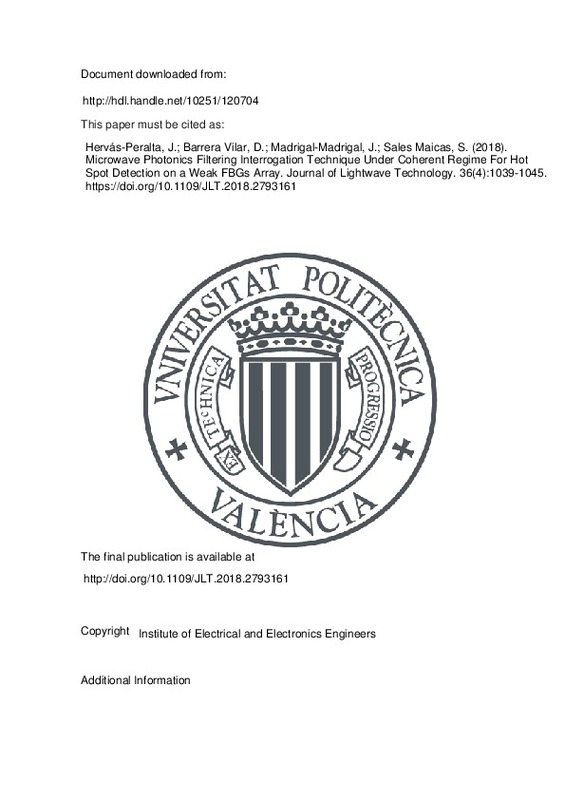JavaScript is disabled for your browser. Some features of this site may not work without it.
Buscar en RiuNet
Listar
Mi cuenta
Estadísticas
Ayuda RiuNet
Admin. UPV
Microwave Photonics Filtering Interrogation Technique Under Coherent Regime For Hot Spot Detection on a Weak FBGs Array
Mostrar el registro sencillo del ítem
Ficheros en el ítem
| dc.contributor.author | Hervás-Peralta, Javier
|
es_ES |
| dc.contributor.author | Barrera Vilar, David
|
es_ES |
| dc.contributor.author | Madrigal-Madrigal, Javier
|
es_ES |
| dc.contributor.author | Sales Maicas, Salvador
|
es_ES |
| dc.date.accessioned | 2019-05-19T20:02:53Z | |
| dc.date.available | 2019-05-19T20:02:53Z | |
| dc.date.issued | 2018 | es_ES |
| dc.identifier.issn | 0733-8724 | es_ES |
| dc.identifier.uri | http://hdl.handle.net/10251/120704 | |
| dc.description.abstract | [EN] An interrogation technique of cascaded FBG sensors based on a microwave photonics filtering technique under coherent regime is presented. The sensing information of a 5-m fiber coil containing 500 weak FBG with a similar central wavelength is retrieved. The FBGs are 9-mm long and the spatial separation between consecutive FBGs is 1 mm. The principle of operation is based on the calculation of the impulse response by recording the electrical frequency response of the system. Hot spot detection, location, and temperature measurement are demonstrated by experimental measurements with a temperature sensitivity of 0.6 dB/°C in a 10 °C range. Fifteen measurements are recorded in order to average them to reduce noise and smooth the saw tooth appearance typical of coherent measurements. The resolution of the proposed interrogation technique is related to the bandwidth of the electrical measurement. We have obtained a resolution of 20 cm for an electrical bandwidth of 1 GHz. The SNR was larger than 16 dB despite the fact that no amplification was used within the system. | es_ES |
| dc.description.sponsorship | This work was supported in part by the Spanish MINECO under Project DIMENSION TEC2017-88029-R, in part by the Generalitat Valenciana (APOSTD/2016/015), in part by the FINESSE funded by the European Union's Horizon 2020 research and innovation programme under the Marie Sklodowska-Curie Action under Grant 722509, in part by the Sistema Nacional de Garantia Juvenil under Grant PEJ-2014-A-24709, and in part by the MECD FPU scholarship under Grant FPU13/04675. | es_ES |
| dc.language | Inglés | es_ES |
| dc.publisher | Institute of Electrical and Electronics Engineers | es_ES |
| dc.relation.ispartof | Journal of Lightwave Technology | es_ES |
| dc.rights | Reserva de todos los derechos | es_ES |
| dc.subject | Fiber Bragg gratings | es_ES |
| dc.subject | Microwave photonics | es_ES |
| dc.subject | Optical sensors | es_ES |
| dc.subject.classification | TEORIA DE LA SEÑAL Y COMUNICACIONES | es_ES |
| dc.title | Microwave Photonics Filtering Interrogation Technique Under Coherent Regime For Hot Spot Detection on a Weak FBGs Array | es_ES |
| dc.type | Artículo | es_ES |
| dc.identifier.doi | 10.1109/JLT.2018.2793161 | es_ES |
| dc.relation.projectID | info:eu-repo/grantAgreement/GVA//APOSTD%2F2016%2F015/ | es_ES |
| dc.relation.projectID | info:eu-repo/grantAgreement/EC/H2020/722509/EU/Fibre Nervous Sensing Systems/ | es_ES |
| dc.relation.projectID | info:eu-repo/grantAgreement/MECD//FPU13%2F04675/ES/FPU13%2F04675/ | es_ES |
| dc.relation.projectID | info:eu-repo/grantAgreement/AEI/Plan Estatal de Investigación Científica y Técnica y de Innovación 2013-2016/TEC2017-88029-R/ES/DISPOTIVOS EN FIBRAS ESPECIALES MULTIMODO%2FMULTINUCLEO PARA REDES DE COMUNICACIONES Y APLICACIONES DE SENSORES/ | es_ES |
| dc.relation.projectID | info:eu-repo/grantAgreement/MINECO//PEJ-2014-A-24709/ES/PEJ-2014-A-24709/ | es_ES |
| dc.rights.accessRights | Abierto | es_ES |
| dc.contributor.affiliation | Universitat Politècnica de València. Departamento de Comunicaciones - Departament de Comunicacions | es_ES |
| dc.description.bibliographicCitation | Hervás-Peralta, J.; Barrera Vilar, D.; Madrigal-Madrigal, J.; Sales Maicas, S. (2018). Microwave Photonics Filtering Interrogation Technique Under Coherent Regime For Hot Spot Detection on a Weak FBGs Array. Journal of Lightwave Technology. 36(4):1039-1045. https://doi.org/10.1109/JLT.2018.2793161 | es_ES |
| dc.description.accrualMethod | S | es_ES |
| dc.relation.publisherversion | http://doi.org/10.1109/JLT.2018.2793161 | es_ES |
| dc.description.upvformatpinicio | 1039 | es_ES |
| dc.description.upvformatpfin | 1045 | es_ES |
| dc.type.version | info:eu-repo/semantics/publishedVersion | es_ES |
| dc.description.volume | 36 | es_ES |
| dc.description.issue | 4 | es_ES |
| dc.relation.pasarela | S\355774 | es_ES |
| dc.contributor.funder | Generalitat Valenciana | es_ES |
| dc.contributor.funder | Ministerio de Educación, Cultura y Deporte | es_ES |
| dc.contributor.funder | Agencia Estatal de Investigación | es_ES |
| dc.contributor.funder | European Commission | es_ES |
| dc.contributor.funder | Ministerio de Economía y Competitividad | es_ES |







![[Cerrado]](/themes/UPV/images/candado.png)

